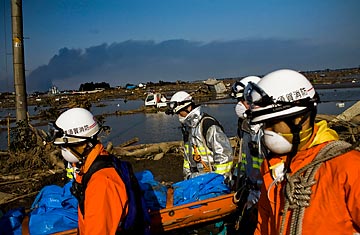
Rescue workers in Natori carry the bodies of two victims after an massive earthquake and Tsunami hit the east coast of Japan.
(2 of 2)
In Miyagi prefecture, a group of students from the Civil Aviation College floated in an inflatable yellow raft across what was dry land just three days before. Some 170 students and airplane-maintenance employees had watched the tsunami roll in from the roof of a school building, where they had decamped after the earthquake triggered a tsunami alert that was broadcast on loudspeakers, radios and TVs. "The tsunami came toward us so slowly that it was hard to understand what was approaching," recalled Satoshi Tsuchira, 24. "But then it came and kept on coming and I wondered if it would ever end."
A 10-m-high wave of water marooned their building and sent a churning mass of vehicles, planes and houses swirling past them. The students kept their eyes on a solitary man who clung to the top of a bobbing truck for a night and gasped as the receding waters pulled dozens of cars out to sea. Those stranded on the roof had only one box of energy cookies for every four individuals. Rationing began, and a cold rain continued. On a nearby road, a forlorn piano lay on its side, along with an office stripped of its wall. After more than 24 hours, the fire department arrived to rescue the trapped students. As they ferried some of their belongings from their dorm to high ground, the prospect of a radioactive cloud possibly making its way toward them was too much to comprehend. "We have suffered through an earthquake and a tsunami," said Koutaro Nousou. "Our college is underwater. I can't deal with another disaster. It's just too much."
As the students gathered up their things to take to an unheated evacuation center where they would sleep two to one blanket, Masahira Kasamatsu was making his way to the Sendai airport. Entering the terminal, he climbed up a suspended escalator that wobbled under his weight and quietly approached a man in a gray jacket who looked like he was in charge. His name was Kenichi Numata. After suffering through the earthquake, Numata immediately headed to the designated high ground — in his case the airport — as he had been taught in the tsunami drills conducted up and down coastal Japan. Numata had watched from the airport as dozens of people succumbed in the surrounding water. He now knew that his house had washed away. "Everything is gone," he said, with a sweep of his hand. "It's all gone."
But there was little time to process this loss. Numata had been designated as one of the section leaders organizing the 1,600 people initially stranded at the Sendai airport. They had been completely cut off, with no cell-phone access or information about what had befallen the rest of the region. "What is your daughter's name, again?" he asked Kasamatsu. The farmer slowly repeated her name and stared into the middle distance. Numata and others conferred. "Yoko Oosato, is it," Numata said. "Why, she went home just a little while ago." It took a moment for Kasamatsu to process the news. He nodded slowly. "She's O.K.," he repeated, as if to convince himself. "She's O.K."
We drove Kasamatsu through the floodwaters back to his wife, who was waiting beside their car, mangled vehicles and twisted buildings all around. As we approached, she dove into her car to offer me an armful of oranges and apples in gratitude for having driven her husband back from the airport. Only as she gathered up the fruit did their eyes meet. "And Yoko?" she asked her husband. "She's O.K.," Kasamatsu replied. "She's O.K." There were no hugs or overwhelming expressions of elation. Their daughter had been spared. But devastation was still all around.
